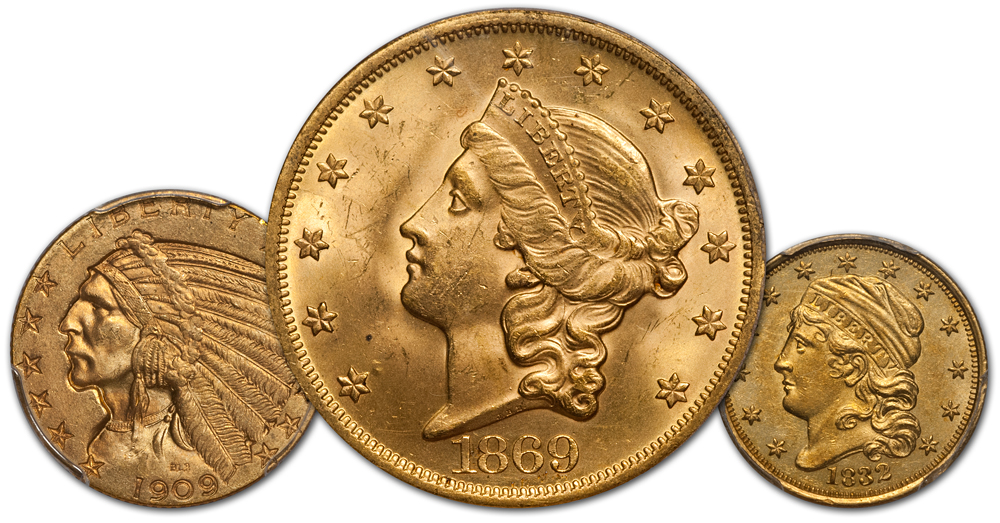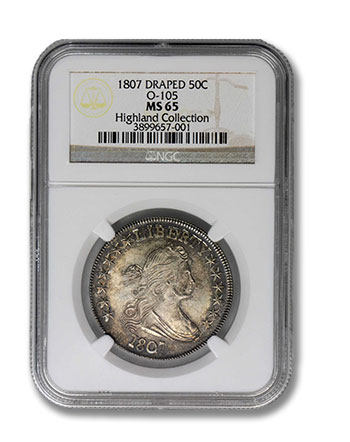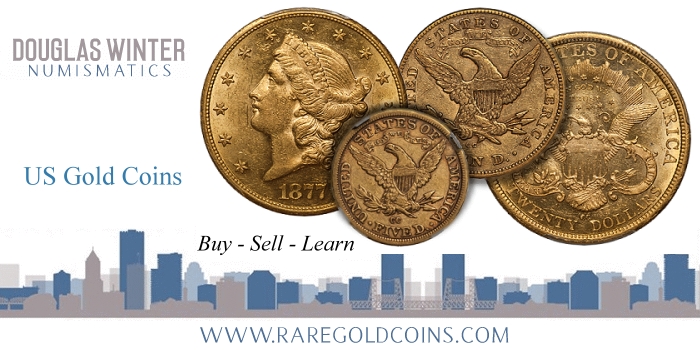By Doug Winter – RareGoldcoins.com
CoinWeek Content Partner ……
There are a few contemporary coin collectors who have it “figured out.” In addition to buying great coins, they have branded themselves (sometimes accidentally) in ways which greatly benefit them when they sell. Examples of collectors who are well-branded include Steve Duckor, Dale Friend, Chuck Link, and the late Gene Gardner. These are collectors who have deservedly great reputations as connoisseurs.
In the case of Steve and Dale (two branded collectors with whom I do business) this has generally meant that when I sell a coin pedigreed to their core collections, it doesn’t necessarily translate to higher prices but it invariably makes the coin more liquid.
What can a collector do to brand his collection and what impact does branding have on a collection? I’d like to share a few insights. But first, I’d like to discuss the concept of branding and how it applies to coin collecting.
Without sounding too egotistical, I think I’ve done a good job of branding myself as far as rare date gold coins go. I’ve written some books, have a dynamic web site, and have focused on a specific area for nearly 30 years without diluting it. Some of the lessons that I’ve learned will be beneficial to you.
As a brand, “Douglas Winter Numismatics” has good recognition both as a knowledgeable seller of rare gold and as a seller who offers choice coins with original surfaces. As a collector, how can you establish a brand which benefits you and your collection, especially when you get ready to sell?

1. Be a Specialized Collector
Most great collectors choose a somewhat narrow focus and become experts in this field. Steve Duckor has chosen Indian Head gold, Saints, and gold dollars. Dale Friend has chosen Bust half dollars and Bust dollars. Chuck Link is a keen collector of Bust halves by die variety, while Gene Gardner was linked with Liberty Seated coinage. Do you see a trend here? Each collector has a focus which enables him to become an expert in a specific area(s). And each has chosen a specialty that’s not too esoteric but isn’t over-promoted.
These four collectors–and others like them–are known for being nice guys who dealers like to sell coins to (thus they get first shot at great pieces) and they are known for being collectors who will share their knowledge. They are students of the series they collect and while to the best of my knowledge none of them has ever written a book on their specialty, their names are forever associated with their areas.
2. Write a Book
This was the path I took to make my brand well-known and respected. It helped that I was an English major in college, sure. This may not be a path that’s feasible for many collectors due to time constraints or inability to write well. In that case, I’d suggest a writing partner.
There is a long tradition in numismatics for collectors to pen books that have become standard references. The current standard references on Bust Dimes, Bust Quarters, and Bust Half Dollars, as examples, were written by collectors and this increase in name recognition has, no doubt, had a favorable impact on their individual collections.
Even if you don’t have in-depth knowledge on your series, you can produce an on-demand book with nice quality photos and interesting information on how you came to purchase each coin in your collection. Better yet, if you have a world-class collection of, say, early gold coinage, choose a dealer to work with who might be able to use your coins and/or your research.
3. Build a Website
Before you read any more of this article, surf on over to godaddy.com and buy the domain name that best represents your collection. Even if you never build a site, it’s a smart defensive mechanism to own your “name” so that someone else isn’t squatting on it.
It’s easy to build a website and I personally suggest Squarespace as the architecture which you should choose. You will probably need to hire a web designer to help you, but the initial outlay shouldn’t be more than $1,000-2,000 USD.
Your website can be simple or it can be dazzlingly complex. I’d suggest you start simple with an “about” page describing who you are and what your collection is, a “coins” area with each specific issue in your collection given a description and imaged obverse and reverse, and a “resources” page with links to other pertinent sites. Have a contact page if you want feedback or if you want to meet other collectors who share your interest(s).
The best collector website I have ever seen is Martin Logies’ earlydollars.org. While outdated from a design and technology standpoint, the information it contains is spectacular and it is a valued resource for early silver dollars.
4. Set Registry: Yes or No?
 Most modern-day collectors are confronted with an important decision to make when considering the PCGS or NGC Set Registry. The decision you are making is based on this question: do you want to share potentially damaging information with dealers and/or rival collectors? I’d say if you are mostly finished with your set then it is OK to share the information. I’d say if you are still lacking important key dates in your collection, it might not be smart to share this information.
Most modern-day collectors are confronted with an important decision to make when considering the PCGS or NGC Set Registry. The decision you are making is based on this question: do you want to share potentially damaging information with dealers and/or rival collectors? I’d say if you are mostly finished with your set then it is OK to share the information. I’d say if you are still lacking important key dates in your collection, it might not be smart to share this information.
Posting your set on the Registry is mostly about ego and if you are a serious, competitive collector you have an ego (maybe a big one). Just remember that you will be trolled by dealers who make a living selling Registry coins and you might give your needs a giant bullseye. By this, I mean that if your set is nearly done but you need three coins, an unscrupulous dealer or collector might “hold you up” knowing that you have to have a specific date to approach completion.
I think the best solution to this problem is posting your set but “locking it” so that it can only be seen by you and the people to whom you want to see it.
5. Branding Your Collection: PCGS and NGC Labels
At some point, your set may be at the stage where you can ask PCGS or NGC to prepare special labels. These labels will have the name of your collection and additional pedigree information.
This brings me to a point which is near and dear to me: the name of your collection. I have a pretty advanced set of Seated Liberty quarters and I jokingly refer to it as the DDub Sittin’ Down Q collection. But when I get to the point of branding it, the collection will be named the Doug Winter Collection of Seated Liberty Quarters. Dumb collection names (I’m looking at you Ylang-Ylang, Rive d’Or, Rainy Day, and Just Having Fun collections…) make me think less of the coins, no matter how good they are.
I understand the need for privacy and the desire for many collections to remain anonymous. If I buy a collection of Liberty half eagles from Richard Jones, I’m probably not going to market it as the Richard Jones collection. Unless (and this is a big “unless”) the collection has already been branded and it is well-known enough to stand on its own merits.
6. Pedigree/Provenance
To me, a good pedigree (or more formally “provenance”) can greatly add to the desirability and value of a coin. If you have the #14 all-time set of American Silver Eagles, this is not an interesting pedigree. But if you have the finest all-time set of Liberty Head double eagles, this is potentially a very interesting pedigree.
Which pedigrees add value to classic United States gold coins? I would say the following 20 modern-era pedigrees (not listed in order of importance) are the most desirable for gold coins:
- Garrett (early gold, Territorial gold, Proof gold)
- Brand (early and Liberty Head gold)
- Amon Carter (Proof gold and business strike early to Liberty Head gold)
- Norweb (regular issue gold)
- Eliasberg (all U.S. gold from 1795 to 1933)
- Bass (business strike and Proof early and Liberty Head gold; die varieties)
- Pogue (U.S. gold, 1795-1839)
- Pittman (business strike and Proof early gold and Liberty Head gold)
- Battle Born: (Carson City gold)
- Duke’s Creek, Chestatee, North Georgia and Green Pond: (all for Dahlonega gold)
- Elrod (Charlotte gold)
- Dallas Bank collection (Liberty Head double eagles)
- Crawford (Liberty Head double eagles)
- Simpson (20th century gold)
- Duckor (gold dollars, Indian eagles, and Saints)
- Ed Price (early quarter eagles)
- Thain Price (20th century gold)
I can easily name another 20 important pedigrees but many of these are from very under-the-radar collections which have not yet been branded.
To me, the most interesting collections are full of coins with old, established pedigrees. This is possible in early copper as this is a well-researched field. This is not as easy for many gold series, even avidly collected ones like Type One double eagles. To determine pedigrees, you need access to a large library of well-illustrated catalogs or a friend with one to help you search. Or better yet, make use of the Newman Numismatic Portal and access their amazing archive of plated catalogs from the late 19th and early 20th century.
If you buy another collection to either begin or supplement your own, make sure to obtain pedigree information from the original collector. He may have important information that will benefit your pedigree search(es).
Let’s say you are assembling a world-class of Liberty Head eagles and your name is John Smith. You purchase two important No Motto San Francisco coins from the Norweb collection. How should the “new” pedigree read? I wouldn’t want to lose the Norweb pedigree as it’s very important, so the new pedigree should read: Smith/Norweb.
7. Summary
Branding is not a new concept as collectors having been doing some form of many of the suggestions made above since the 19th century. However, with so many new options available to collectors it is easier to do than it was pre-Internet.
Branding helps create an exit strategy; something that many collectors don’t give thought to until it’s too late. If some sort of personal crisis befalls you or your family, you may have to sell your collection on short notice. Selling a well-branded collection should be easier than selling one which is unorganized and not prepared to reach its full financial potential.
Are you interested in creating a branded collection? I have the capability to create a magnificent presentation for you and I have done this for many other collectors in the past few decades. To discuss branding your collection, contact Doug Winter by phone at (214) 675-9897 or via email at [email protected].

About Doug Winter
 Doug has spent much of his life in the field of numismatics; beginning collecting coins at the age of seven, and by the time he was 10 years old, buying and selling coins at conventions in the New York City area.
Doug has spent much of his life in the field of numismatics; beginning collecting coins at the age of seven, and by the time he was 10 years old, buying and selling coins at conventions in the New York City area.
In 1989, he founded Douglas Winter Numismatics, and his firm specializes in buying and selling choice and rare United States coins, especially US gold coins and all branch mint material.
Recognized as one of the leading specialized numismatic firms, Doug is an award winning author of over a dozen numismatic books and the recognized expert on US Gold. His knowledge and exceptional eye for properly graded and original coins has made him one of the most respected figures in the numismatic community and a sought after dealer by collectors and investors looking for professional personalized service, a select inventory of impeccable quality and fair and honest pricing. Doug is also a major buyer of all US coins and is always looking to purchase collections both large and small. He can be reached at 214-675-9897.
Doug has been a contributor to the Guidebook of United States Coins (also known as the “Redbook”) since 1983, Walter Breen’s Encyclopedia of United States and Colonial Coins, Q. David Bowers’ Encyclopedia of United States Silver Dollars and Andrew Pollock’s United States Pattern and Related Issues
In addition he has authored 13 books on US Gold coins including:
- Gold Coins of the New Orleans Mint: 1839-1909
- Gold Coins of the Carson City Mint: 1870 – 1893
- Gold Coins of the Charlotte Mint: 1838-1861
- Gold Coins of the Dahlonega Mint 1838-1861
- The United States $3 Gold Pieces 1854-1889
- Carson City Gold Coinage 1870-1893: A Rarity and Condition Census Update
- An Insider’s Guide to Collecting Type One Double Eagles
- The Connoisseur’s Guide to United States Gold Coins
- A Collector’s Guide To Indian Head Quarter Eagles
- The Acadiana Collection of New Orleans Coinage
- Type Three Double Eagles, 1877-1907: A Numismatic History and Analysis
- Gold Coins of the Dahlonega Mint, 1838-1861: A Numismatic History and Analysis
- Type Two Double Eagles, 1866-1876: A Numismatic History and Analysis
Finally Doug is a member of virtually every major numismatic organization, professional trade group and major coin association in the US.





Hi Doug,
I liked your article on branding……..thank you.
Do you know if PCGS or NGC will put the owners name ova coin on their slab?
Requirements?
I am an Oregonian full time now.
Thank you,
Dan Whyman